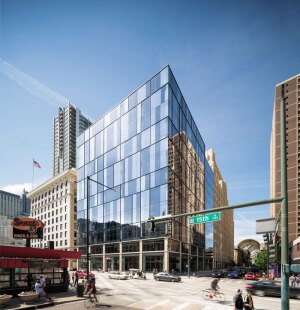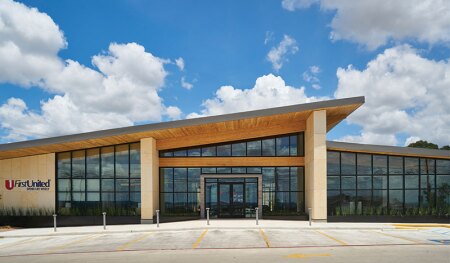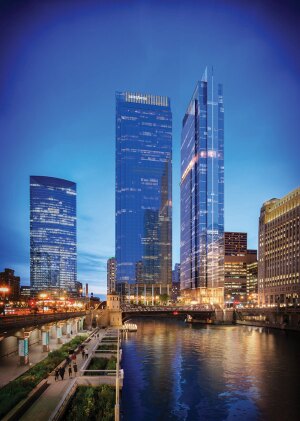Every component of a building, from the concrete foundation to the paint on the walls, has an impact on human health, the climate, and ecosystems around the globe. Building materials—once overlooked in real estate’s sustainability efforts—are now being recognized as key to achieving net zero carbon emission targets and delivering healthy places for tenants and communities.
For First United Bank, a regional bank headquartered in Durant, Oklahoma, choosing the right construction materials for its new branch locations became an important way for the company to outwardly express its people- and planet-focused values.
“First United wanted the buildings to integrate and showcase sustainable strategies while inspiring and relating to their customer base,” according to project architect, Taylor Coleman, a senior associate at Gensler. “Using mass timber proved to be an excellent way to achieve these goals.”
The inviting, light-filled lobby of First United Bank’s branch in Fredericksburg, Texas, is characterized by wood—lots of it. Completed in 2019, the 8,500-square-foot (790 sq m) building was the first fully mass timber structure in the state and the first project in the country to use cross-laminated timber (CLT) panels made from southern yellow pine, a locally grown and sourced wood.
Compared with traditional materials like concrete and steel, mass timber has a much lower environmental impact and has been shown to improve occupant health and well-being by evoking nature—a concept known as biophilia.
After completing the Fredericksburg branch, First United Bank and Gensler partnered on two additional mass timber bank buildings in Shawnee, Oklahoma, and Sherman, Texas. Gensler is now designing more than 2 million square feet (185,800 sq m) of mass timber buildings for Walmart’s new home office campus project in Bentonville, Arkansas, and working on Under Armour’s Baltimore global headquarters, another fully mass timber project.
These projects are representative of a larger industry trend favoring sustainable construction materials.Over the last decade, this movement has mainly been championed by architecture and design firms, but real change will be possible only with coordinated efforts across the industry, says Diane Hoskins, Gensler’s co-CEO. “The decarbonization of the built environment is a complex challenge requiring the entire real estate sector to move toward low-carbon solutions.”
Spurred by increasingly restrictive regulations, reporting requirements, and growing demands from investors and tenants, the industry’s sustainability efforts are now taking materials into account.
An upcoming ULI report, The Material Movement: Creating Value with Better Building Materials, outlines the driving forces behind this shift and highlights key steps that developers and asset managers can take to mitigate their environmental impact and enhance health through building materials.
Living in a Material World
A building material’s full life cycle includes its extraction, manufacturing, transportation, installation, replacement, and eventual disposal. Combined, the greenhouse gas emissions from these processes—known as embodied carbon—are responsible for about 11 percent of total emissions worldwide. It is estimated that embodied carbon can represent up to half of a building’s overall carbon footprint over its lifetime.
Less visible—but no less significant—are the myriad ways that building materials affect human health. On average, people spend about 90 percent of their lives indoors. Compounds released from building materials, interior furnishings, paints, flooring, and adhesives enter the air and then people’s bodies, causing a range of negative health effects.
While building materials today are much better than they were several decades ago, a lot of room for improvement remains.
“There is just not enough data about most building materials to properly evaluate them for their potential to affect human health,” says Frances Yang, Arup’s sustainable materials practice leader. “The industry can address this by demanding increased transparency about what products are made of, how they are made, and where their ingredients come from.”
Racial and social equity disparities compound these challenges. People of color and those with low incomes are more likely to have material manufacturing facilities sited in their neighborhoods and suffer negative health effects due to higher concentrations of pollution both inside and outside their homes.
“Material selection is a social justice issue,” says Gina Ciganik, CEO of the Healthy Building Network, a nonprofit organization that conducts scientific research and provides education and solutions to increase transparency in the building products industry. “Opting for nontoxic products not only creates healthy buildings, but it results in positive ripple effects for communities around the world.”
A Material Difference
Seeing the importance of building materials, tenants are pushing the industry to adopt cleaner products in real estate developments.
For example, large end users like Google, Salesforce, Meta, Microsoft, Kaiser Permanente, and many others have established rigorous material evaluation frameworks for their development projects. In fact, Salesforce has published two detailed guides describing their Healthy & Sustainable Materials Program, which provide guidance to firms wishing to improve their material selection.
Their first piece of advice? Don’t wait—now is the time to start taking action.
Salesforce’s strategy seems to be working. The company’s latest tower in downtown Chicago—a 60-story, 1.2 million-square-foot (111,500 sq m) office building—achieved a 19 percent reduction in embodied carbon emissions compared with baseline.
Developer Hines and structural engineer Magnusson Klemencic Associates (MKA) maximized the building’s structural efficiency (thereby reducing the amount of material needed) and specified low-carbon concrete and recycled steel to drive down emissions.
Although a 19 percent embodied carbon reduction may not sound like a lot, it equates to a carbon saving exceeding 7 million kilograms (15.4 million lbs) of carbon dioxide, equivalent to pulling 1,500 cars off the road for a year.
Meanwhile, the building’s interiors are on track to achieve Leadership in Energy and Environmental Design v4 Platinum, the highest LEED certification, by incorporating cutting-edge healthy, and sustainable products like carbon-neutral carpet made with 100 percent recycled nylon from fishing nets.
Fortunately, Hines and MKA are sharing their wisdom with the industry—their joint Embodied Carbon Reduction Guide documents strategies for measuring and reducing embodied carbon at all stages of development, and is free and available to the public.
“We hope other professionals and developers are inspired by the guide, and work to implement embodied carbon reduction strategies on their own projects, collectively moving the industry forward,” says Sean Clifton, senior principal at MKA.
Health Is Wealth
While embodied carbon has become top of mind for many in the industry, occupant and employee health is creeping closer to the top of the priority list, especially in the wake of the COVID-19 pandemic.
Many developers have discovered that investing in health pays off. Healthy, efficient buildings with improved indoor air quality have been shown to boost employee productivity and reduce sick days. As a result, certified healthy buildings transact 4.4 to 7.7 percent higher rent per square foot than noncertified buildings and achieve better leasing rates, according to a study conducted by the MIT Real Estate Innovation Lab.
And it is not just office buildings that are switching to better products. AvalonBay, a real estate investment trust that owns nearly 80,000 apartments across the United States, is thinking about how its material selection affects the residents who call their buildings home.
“We build and operate homes for our residents—places they live and work. This means the composition of materials we select influences not only the look of a home but also air quality, health, and our carbon footprint. We want to look at material health comprehensively—meaning not just chemical toxicity, but also climate health, ecosystem health, circularity, and social justice and equity,” says Katie Rothenberg, vice president, environmental, social, and governance (ESG), for the firm.
Carbon and Chemical Regulations and Real Estate
Regulations on embodied carbon and chemicals also are spurring change.
Policies requiring real estate to track and mitigate embodied carbon have become the norm in many European countries and Canada, and are now taking hold across the United States.
There are 29 U.S. cities with policies or action plans that address embodied carbon, according to the Carbon Leadership Forum (CLF), an organization at the University of Washington that advances research and education about reducing embodied carbon in buildings and infrastructure.
New carbon disclosure rules also are prompting change across the industry. Last year, the U.S. Securities and Exchange Commission (SEC) proposed mandatory climate reporting for all publicly listed companies.
While it is unclear if embodied emissions from construction will be included in the rule, the proposal has already motivated some real estate leaders to start analyzing supply chains and development practices to cut carbon.
On the health side, the U.S. Environmental Protection Agency is ramping up efforts to regulate certain classes of chemicals commonly found in building products, namely per- and polyfluorinated substances (PFAS). PFAS are a class of 7,000-plus manmade chemicals that have many useful applications, but never degrade in the environment and can be harmful to humans and wildlife. For this reason, they are referred to as “forever chemicals.”
Although the real estate industry has contributed to chemical production and pollution, it can play a significant role in the solution.
“Developers and their project teams have the power to shift the industry away from toxic products. When project teams specify PFAS-free materials, it encourages manufacturers to optimize their products and remove substances that harm people and the planet,” says David Johnson, vice president of projects at AGI Avant Group, an ESG purpose-driven real estate investment and development firm based in San Jose, California. “Over time, we can advance a toxic-free future.”
Strategies for Reducing Embodied Carbon and Improving Material Health
Stakeholders across the industry are advancing innovative solutions that make it easier to build with green materials. Incremental changes throughout the development process can have outsized impacts on the health and sustainability of the final project.
Project visioning and predesign. A project team should begin by asking if reusing an existing building could meet future programming needs. Adaptive use is the single most effective way to drive down carbon and avoid pollution from chemical production—next to not building anything at all.
As an example, Gensler repurposed a 12-story, 230,000-square-foot (21,400 sq m) vacant telecom building in downtown Denver and reduced embodied carbon emissions by 68 percent. Preserving the original building’s steel and concrete structure, which contained the highest concentration of embodied emissions, led to the project’s success.
After the building was complete, Gensler leveraged Tally, a life-cycle assessment tool, to quantify its embodied carbon achievement.
When reuse isn’t an option, teams should explore reworking systems to improve structural efficiency and use fewer materials, or consider low-carbon alternatives like mass timber.
Design and material specification. This stage of development is about details. Finding, evaluating, specifying, and procuring products are best driven by the project’s goals and informed by transparent product information.
From there, understanding the materials and products that are likely to have high embodied carbon and potentially toxic chemicals is a useful place to start. High-embodied-carbon materials include concrete, steel, flat glass, and asphalt. Potentially unhealthy materials include anything plastic based and certain kinds of carpet, adhesives, coatings, paints, finishes, and furniture.
While selecting and procuring materials can feel daunting at times, it is important not to get discouraged when products do not check all the boxes.
“Perfection is an enemy of progress,” says Amanda Kaminsky, director of sustainable construction–Americas, for Lendlease, a $10 billion multinational construction and property company based in Sydney, Australia.
“I don’t know of a perfect material,” she explains. “However, purchasing materials with transparent, publicly posted, product-specific documentation of incremental human and environmental health improvements that matter to you/your organization can result in impactful benefits for tenants, contractors, manufacturing communities, and our climate and resources.”
While there is likely no such thing as a perfect material, innovations in material science have given rise to new products that are designed with sustainability in mind.
In the concrete space, CarbonCure Technologies, a company based in Halifax, Nova Scotia, created a process that collects carbon dioxide emissions from the atmosphere and injects them into concrete during the mixing process. The emissions are then transformed into a mineral and locked into the concrete, where they cannot add to global warming.
Insulation is another product category where bio-based alternatives are becoming popular. Mycelium, the thin root fibers of fungi, are packaged between wooden panels where they create airtight insulating walls.
Free from petroleum-based substances, the mycelium panels are nontoxic and recyclable and perform just as well as traditional insulation products.
These products and others hold the promise of a regenerative materials economy that supports the health of people, communities, and ecosystems around the globe.
Construction and operations. Microsoft and its contractors Skanska Balfour Beatty, Sellen Construction, and GLY Construction worked together to track and reduce carbon from material transportation and construction activities for Microsoft’s Redmond, Washington, campus modernization project, which involves the construction of 17 buildings and roughly 3 million square feet (278,700 sq m) of new workspace and amenities.
The team discovered that the emissions from construction activities contribute to about 10 to 20 percent of the project’s total embodied carbon emissions, more than double their original estimate. Seeking alternative modes of transport, using alternative fuels, or using all-electric vehicles can support the reduction of on-site carbon emissions.
During operations, developers and managers can encourage tenants to leverage the material libraries mentioned previously and specify healthy, low-embodied carbon materials for fit-outs and equipment replacements. Office furniture, carpet tiles, and ceiling panels can be reused many times before reaching the end of their useful lives, saving carbon emissions and reducing waste.
With the global building stock expected to double by 2060, addressing embodied carbon and material health is essential for achieving net zero targets and ensuring healthy and equitable communities for generations to come. By reusing materials; specifying healthy, low-carbon products; and seeking opportunities to reduce carbon and chemicals at each stage of development, the real estate sector can create buildings and places that are good for people and for the planet. UL
VICTORIA OESTREICH is a senior manager at the Urban Land Institute, where she supports a wide array of programming and research focused on the intersections of sustainability, health equity, and the built environment.








